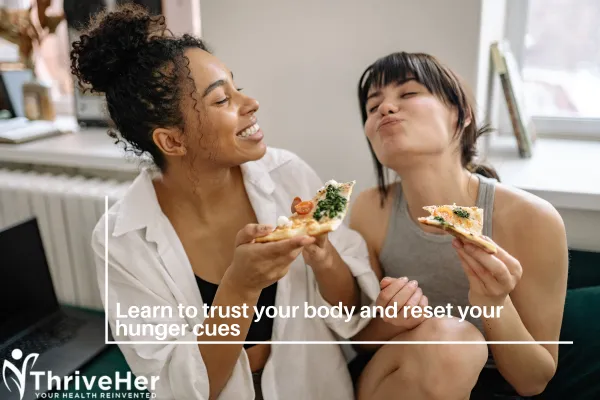
Struggling with Intuitive Eating? Here’s Why—And How to Fix It
Ever tried intuitive eating and thought, Yes! No more dieting!—only to find yourself standing in front of the fridge, searching for something that actually feels satisfying?
Or maybe you’ve tried to “just listen to your body,” but your body keeps screaming for sugar, bread, or whatever’s easiest to grab.
And then the guilt kicks in. Why can’t I eat like a normal person? Why do I feel hungry all the time? What’s wrong with me?
First things first—you are not broken. Your body isn’t working against you; it’s just been given the wrong signals for years.
And if you’re in your late 30s or 40s, things might feel even harder—because perimenopause is shifting the way your body processes hunger, cravings, and satisfaction.
So if intuitive eating has felt impossible for you, here’s the truth: it’s not your fault—but it is fixable.
What Intuitive Eating Actually Is (and Why It Feels Impossible Right Now)
At its core, intuitive eating is about rebuilding trust with your body.
It’s about getting back to a place where food feels easy—where you eat when you’re hungry, stop when you’re full, and don’t spend half your mental energy stressing over every bite.
And guess what? We were all born intuitive eaters.
Just think about babies—they cry when they’re hungry, stop when they’re full, and don’t waste time worrying about carbs vs. protein. Their bodies tell them exactly what they need.
But somewhere along the way, we lose that connection.
🔹 Diet culture teaches us to ignore hunger. We’re told to skip meals, suppress cravings, and follow rigid food rules.
🔹 Processed foods hijack our appetite. Ever notice how easy it is to overeat chips, but not salmon and veggies? That’s because ultra-processed foods override our natural fullness cues, making us crave more instead of stopping when we’re satisfied.
🔹 Perimenopause changes everything. Even if you never had food struggles before, shifting hormones can make hunger, cravings, and satisfaction completely unpredictable.
So if intuitive eating hasn’t “worked” for you, it’s not because you’re doing it wrong. It’s because your body is simply getting mixed signals—and it’s time to reset them.
Why Intuitive Eating Feels So Hard (Especially in Your 30s & 40s)
If you’ve ever thought, If I listened to my body, I’d just eat carbs all day, I want you to hear me loud and clear:
Your cravings are real—but they don’t always mean what you think they do.
Here’s what’s actually happening:
1️⃣ Years of Dieting Have Disrupted Your Hunger Cues
Ever skipped breakfast to “save calories”? Forced yourself to wait for lunch, even though you were starving?
Every time you override your hunger, you teach your body not to trust that food will be available—so when you do eat, your body panics, slowing metabolism and increasing cravings.
2️⃣ Processed Foods Have Rewired Your Appetite
Ever eaten a whole bag of chips without feeling full? But one plate of real food leaves you totally satisfied?
That’s not just about calories—it’s how food affects your hunger hormones.
🔹 Processed foods trigger dopamine (the brain’s reward chemical), making you crave more instead of stopping when you’ve had enough.
🔹 Real, whole foods nourish your body, keeping hunger and cravings stable.
3️⃣ Perimenopause Messes With Your Hunger, Cravings & Satisfaction
If you feel like your appetite changed overnight, you’re not imagining it.
✅ Estrogen dips make you less sensitive to leptin (the fullness hormone)—so you might feel hungrier, even after eating enough.
✅ Insulin resistance makes blood sugar crashes worse—leading to intense carb cravings.
✅ Cortisol (your stress hormone) increases emotional eating, making you reach for sugar & comfort foods.
✅ Serotonin dips leave you feeling unsatisfied after meals—so you keep looking for more.
Sound familiar?
How to Reset Your Hunger & Fullness Cues (So Intuitive Eating Actually Works for You)
1️⃣ Balance Blood Sugar First
If your blood sugar is crashing every few hours, your cravings aren’t real hunger—they’re just your body begging for stability.
Start here:
✅ Add protein, fat, and fiber to every meal.
✅ Swap carb-only snacks (granola bars, crackers) for something with protein.
✅ Eat breakfast! No more “just coffee.”
2️⃣ Crowd Out Processed Foods (Without Restriction)
You don’t have to “cut out” anything cold turkey. Instead, focus on adding more nutrient-dense foods.
Try this:
✅ Swap milk chocolate for dark chocolate with almonds.
✅ Choose sourdough instead of ultra-processed white bread.
3️⃣ Slow Down & Actually Listen to Hunger
✅ Before eating, pause. Ask: Am I actually hungry, or just craving something?
✅ Eat at a 3-4 on the hunger scale (hungry, but not starving).
✅ Stop at a 6-7 (satisfied, not stuffed).
The more you practice, the easier it gets.
Final Thoughts: Small Shifts Lead to Big Changes
If intuitive eating hasn’t worked for you in the past, that doesn’t mean it never will. It just means your body needs time to reset.
And you don’t have to overhaul everything overnight.
🌱 Start small. Swap one processed snack for a whole food alternative.
🌱 Pay attention to hunger just once today—without judgment.
🌱 Slow down and actually taste your next meal.
Because when you focus on small, sustainable changes, those tiny shifts start adding up.
And if you’re ready to get back in tune with your body, the free ThriveHer Ignite Membership is the perfect place to start.
🔗 Join for free at ThriveHer.VIP and take the first step.
🎧 Want more? Listen to the full ThriveHer Podcast episode:
📲 Listen now on your favorite platform:
🔹 Spotify
🔹 YouTube
🔹 Audible
🔹 Captivate
